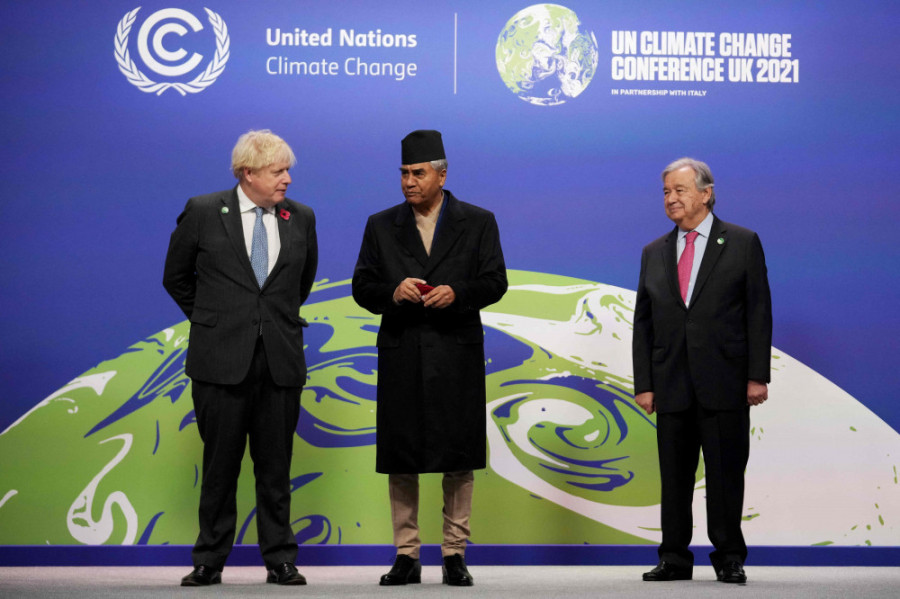Climate & Environment
COP26 and Nepal’s climate commitments
The pledges are ambitious yet achievable but implementation will be key, experts say.
Aakriti Ghimire
On November 8, People’s Climate Mobilization—a group of 20 organisations—staged demonstrations on climate justice at Basantapur in Kathmandu.
Around 80 demonstrators participated with placards that read “Climate Justice Now!” with slogans describing the urgency of the situation and art exhibits to highlight climate change issues.
“We demonstrated to show solidarity with those marching at COP26 with the agenda of climate justice,” said Dristy Shrestha, 29, research officer at Digo Bikas Institute.
The demonstration was organised amid the 26th Conference of Parties to the UN Framework Convention on Climate Change in Glasgow, Scotland.
Prime Minister Sher Bahadur Deuba represented Nepal in the climate conference attended by world leaders.
The climate summit, billed as “last, best hope” that opened on October 31 over the past few days has seen divided opinions on how much progress has been made. Meanwhile, heads of state and industry honchos have made new promises.
Climate and energy experts in Nepal have applauded Nepal’s commitments to climate justice presented at COP26. However, they are concerned that the commitments will not be realised due to insincerity in implementation, and a lack of strategic planning in developing the necessary infrastructures.
Addressing the World Leaders Summit on November 1, Prime Minister Deuba called for recognising the mountains’ climate vulnerability highlighting that “around 80 percent of Nepal’s population is at risk from natural and climate-induced hazards” and “during the last 40 years, natural disasters have caused close to $6 billion in physical and economic damage” in Nepal alone.
Nepal is extremely vulnerable to climate change. The melting glaciers threaten the livelihoods of the region’s residents and have the potential to impact 1.4 billion people. Having experienced changes in temperature and precipitation at a rate faster than the global average, the global North’s commitments to climate financing are crucial to Nepal. Despite contributing only 0.027 per cent to the total global emissions, Nepal has realised its responsibility in mitigating these climate risks.
On November 9, Mountain Day at COP26, Minister for Forests and Environment Ramsahay Prasad Yadav announced Nepal’s world-leading commitment to “emit ‘no net’ carbon between 2022 and 2045 and become carbon negative after”.
In this major event co-hosted by the British embassy in Kathmandu, and the International Centre for Integrated Mountain Development (ICIMOD) at COP26, Nepal also committed to halting deforestation and increasing forest cover to 45 percent and ensuring that all vulnerable people are protected from climate change by 2030.
A statement following the event highlights that Nepal’s commitments to decarbonisation have been applauded as “unprecedented” by Ken O’Flaherty, UK COP26 Climate Ambassador for South Asia.
“Nepal’s commitments are ambitious but achievable,” said Bhushan Tuladhar, an environmentalist and clean energy expert. “It is great that we have goals that are realistic, time-bound, and measurable. The major question that follows is—how do we go about implementing them?”
Madhukar Upadhya, a climate expert, echoed Tuladhar.
“Nepal has always set ambitious goals but failed in realising them because we lag in implementation,” said Upadhya.
A detailed and well-outlined roadmap to achieving the goals is the need of the hour. Nepal severely lacks the infrastructure to realise these commitments. Hence, strategic planning in laying the foundations to achieve climate justice is fundamental, experts say.
Upadhya is optimistic about Nepal’s climate mitigation policies, as outlined in the second Nationally Determined Contribution (NDC).
“The forest cover at the moment is 37.4 percent, so achieving 45 percent is doable in the next nine years. Likewise, Nepal doesn’t contribute greatly to carbon emissions so achieving ‘no net’ emissions is also very likely if we can focus on alternative sources of energy—hydropower and solar power,” Upadhya told the Post.
However, Nepal’s lack of physical and institutional infrastructures may pose barriers to achieving these ambitions. Not only is Nepal’s infrastructure unreliable to sustain any climate-induced changes such as heavy floods, but the leadership also lacks sincerity and vision in seeing through the implementation of various policies, experts say.
“Nepal has committed to relying on clean energy sources but our hydropower projects don’t work during heavy floods. October rains damaged bridges and roads,” said Upadhya. “A lot of our physical infrastructure is unable to sustain climate change-induced disasters.”
In the NDC, Nepal has also committed to increasing sales of e-vehicles (EVs) to cover 25 percent of all private passenger vehicles sales, including two-wheelers and 20 percent of all four-wheeler public passenger vehicle sales by 2025.
By 2030, the aim is to ensure that 90 percent of all private passenger vehicle sales, including two-wheelers, and 60 percent of all four-wheeler public passenger vehicle sales are EVs.
Pramod Bhandari, senior executive at Agni Energy Pvt Ltd, is not thrilled by these commitments.
“The government said the same thing five years ago, and where are we now? They’ll say the same thing five years on. It is impossible to meet the targets for 2025, which is four years from now if we don’t already have a concrete game plan,” said Bhandari.
Despite Nepal’s touted capabilities of generating 83,000 megawatts (MW) of electricity utilising its hydropower resources, Nepal’s electricity consumption is lower than other developing countries’. There are technical, social, economic, and institutional barriers to electricity development in Nepal. Realising Nepal’s commitments at COP26 to achieving no net emissions and transitioning to 15 percent clean energy requires extensive planning.
Nepal’s commitments, albeit long-term, might fail due to a myopic and substandard roadmap.
Highlighting the government’s lack of planning in sustaining EVs in 2021, Bhandari emphasised the need for taking action now.
“Three crucial things need to be done to promote the sales of electric vehicles in Nepal—establishing service centres, setting up charging stations, and subsidising the cost of spare parts. However, there have been no directives or blueprints designing the infrastructure to sustain electric vehicles in Nepal, thus far,” said Bhandari.
If the government plans on a massive reach of EVs, then necessary infrastructures—plans for well-designed and spaced charging stations, plans to subsidise the cost of electricity, and the cost of public passenger buses—have to be prepared early on, experts say.
“Which countries will we import vehicles from? Will we assemble parts here instead? What kinds of charging ports should we install? The government has reduced taxes on EVs but the spare parts are still expensive. Where will the charging stations be set up? There are so many details to be taken care of—a blanket statement isn’t going to be sufficient,” says Bhandari.
“Individuals can’t seek environment-friendly alternatives without substantial support from the government. They shouldn’t bear the burden of the government’s politicisation of policies,” shares Bhandari.
If the government plans on achieving the ‘no net’ carbon emissions by 2045, policies and regulations have to be introduced well in advance, experts say. And the devil lies in the details.
“If Nepal wants to achieve clean energy, then public passenger vehicles should also be encouraged to switch to electric modes. India subsidises up to INR 5,000,000 for those who wish to purchase public passenger electric vehicles. Nepal should also introduce such policies,” said Tuladhar, a board member of Sajha Yatayat.
In addition, the government from now on should only purchase electric vehicles to set an example and encourage the public, according to Tuladhar.
During the climate conference, a host of countries have made new and ambitious commitments.
On November 10, the United States and China—the world’s largest carbon-dioxide emitters—pledged to cooperate in limiting the increase in global average temperature below 1.5 degrees Celsius through decarbonisation, electrification, and transition to clean energy. While the US-China climate agreement was unexpected, activists are cautious in welcoming their commitments.
The US is aiming for net-zero by 2050, whereas China and Russia aim for carbon neutrality by 2060, with peak emissions by 2030.
India—whose major source of energy is coal—plans to achieve net-zero emission by 2070 and fulfill 50 percent of its energy requirement through renewable sources by 2030, whose roadmap isn’t available yet. In an unexpected move, Indian Prime Minister Narendra Modi also announced that they would reduce 1 billion tonnes of carbon dioxide by 2030.
The draft text of the COP26 deal was published by the UK as conference president on Wednesday. However, developing countries are dissatisfied with the financial commitment outlined in the draft for vulnerable countries.
Nepal, on its part, has said to realise its commitments, it needs the support and cooperation from rich nations.
Nepal’s realisations of its commitments, as Minister Yadav said in Glasgow, are contingent upon securing around $250 billion of finance. Nepali leaders are encouraging climate investors and the rest of the world at COP26 to help achieve these ambitious targets.
However, Nepali climate experts believe that the realisations depend not only on aid money but also on a detailed and transparent roadmap.
“The protocols and regulations that the Nepal government introduces will highly dictate the realisation of these climate ambitions. By 2025, Nepal says the metropolitan cities will have bicycles and pedestrian lanes. Where’s the plan?,” said Tuladhar.
“It is time to walk the talk.”




 11.12°C Kathmandu
11.12°C Kathmandu








%20(1).jpg&w=300&height=200)

